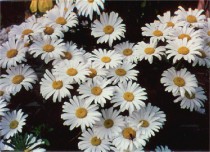






Perennial, Chrysanthemum maximum (Asteraceae)
Shasta Daisies may be the most popular of all daisies. This perennial is easy to grow, and puts on an extended show when in bloom. The cheerful, pure white petals and bright yellow centers, are perfect in almost any garden setting.
Place this daisy in the flower garden, in a mixed border, or in a container on your patio or deck. Shasta Daisies look equally good as a stand-alone plant.
Shasta Daisies make great cut flowers, brightening up any room they are placed in. They are also popular in floral bouquets.
Plant Height: 2 to 3 feet
Shasta Daises are easily started from seeds. Directly sow seeds outdoors after danger of frost has past, and the soil begins to warm. They can also be started indoors, if you prefer.
Plant Shasta Daisies in year one, and they will bloom the second and each following year.
You can also divide and separate established plants. Separate them every three or four years, and they will reward you with bigger blooms. If you do not do this, the plants will begin to crowd each other out, competing for nutrients. As a result, both the plants and the blooms will be smaller.
Days to Germination: seeds sprout in 10 - 21 days.
Easy to grow. Grow plants in full sun.
Daisies like a rich, well drained soil. Mix compost into the planting site, when first planting. They are a hardy and forgiving plant, tolerating poorer soils and partial shade. They need little attention during the year.
For optimum results, apply a general purpose fertilizer in the spring, after the plants have begun to grow. Then, apply again every month or two throughout the season. Just before blooming, provide a fertilizer high in Phosphorous to help promote big, bright blooms.
Keep soil moist, especially during hot, dry periods.
Mulch around plants to keep weeds down, and for a neat and tidy appearance.
Staking plants is sometimes required, especially is grown in partial shade.
Days to Germination: 10 - 21 days, depending upon variety
Flowers Bloom: Summer to Fall
Daisies seldom are bothered by insects and disease. Generally, these plants do not need insecticides or fungicides.
If insect or disease problems occur, treat them early with an insecticidal soap and /or fungicide.
Copyright © www.100flowers.win Botanic Garden All Rights Reserved